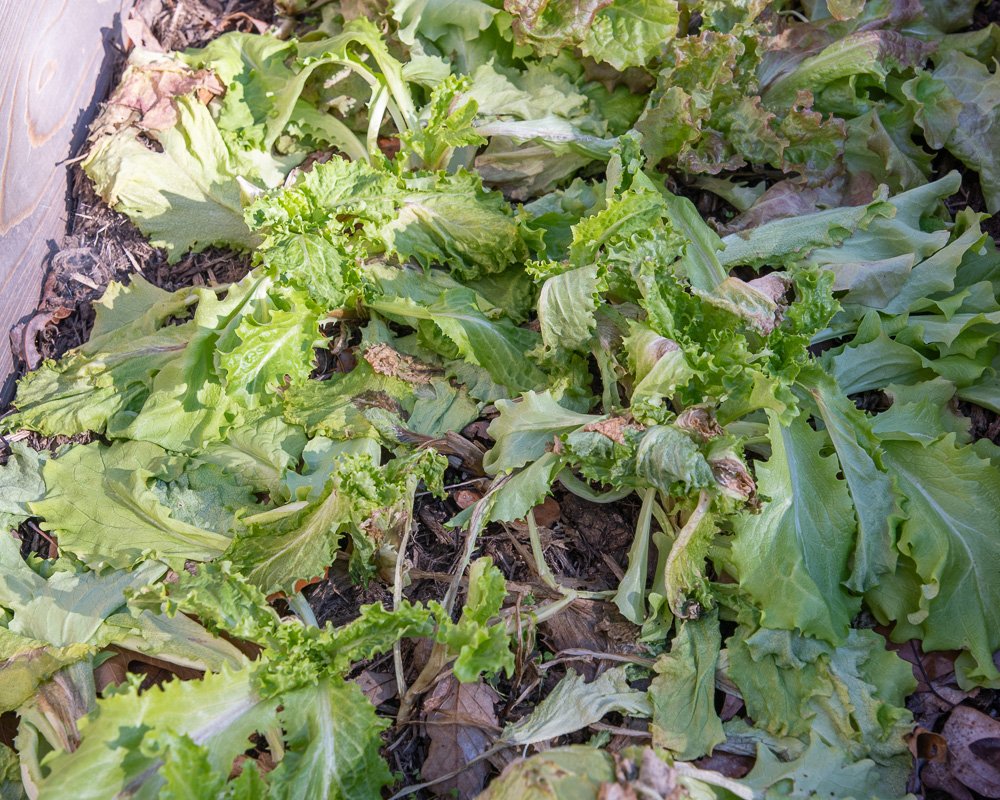by Mark levisay
Last fall I planted two separate areas of lettuce and spinach in my garden to provide us with salad greens throughout the fall and winter seasons. In my main vegetable garden, I planted a row consisting of green leaf lettuce (Starfighter), red leaf lettuce (New Red Fire) and butterhead (Adrianna) on September 15th 2021. I had to replant some of the lettuce due to spotty germination in the heat on 9/27/2021. And then on 10/6/2021, I planted spinach (Kolibri) at the far end of the row. The bed was open, until hard frost threatened and I covered it with a medium weight fabric.
Covered bed in main vegetable garden. Note that sugar snap peas on the fence are thoroughly frosted.
I planted the same varieties of lettuce and spinach listed above in our cold frames on October 8th. Located along the south facing side of our garage, we have two eight-foot long cold frames which were assembled from kits purchased from Gardeners Supply Co. The cold frames are nice, as they can be left open until frost is expected, then the tops can be closed during the below freezing temperatures and opened again when temperatures rise.
Cold frames on the south side of the garage. Photo taken Christmas day, 2021!
Fresh greens through the holidays
Lettuce is fairly cold tolerant, and spinach especially so. With the aid of the fabric cover, and cold frame structure we had a successful crop of both through December and into early January. This can be partly attributed to the weather, which though cold in November was pretty mild in December. Over the years we’ve noted that New Red Fire lettuce, which is one of our favorites in the Spring garden, is exceptionally cold hardy and does very well in both the covered bed and cold frame.
Covered bed opened for harvesting on Christmas Day, 2021.
Really cold weather arrives
Now comes trouble, weather wise. The big snow storm hit on January 3rd, and much colder temperatures followed throughout much of January. The covered bed and cold frame provide good protection from the heavy snow, which can physically flatten the lettuce and spinach plants. It’s the cold, which has dropped toward 10F on some nights that has finally caused some trouble with the lettuce.
Frost “burned” lettuce in the cold frame 2/6/2021, but it will recover.
The lettuce hasn’t been killed, but the outer, larger leaves have been badly damaged by the extreme cold and can’t be harvested. These plants will recover when warmer weather arrives and new growth will come out of the central crown to replace the frosted leaves, which I will remove. This lettuce will be harvestable long before the spring planted lettuce is ready. I’ll water them with a liquid soluble fertilizer at the end of February to help accelerate new growth.
Spinach, on the other hand, is very hardy and does fine even in our coldest weather, as long as it’s not physically covered by snow and ice. These plants will really take off when the weather starts to warm and days grow longer-much earlier than spring planted lettuce. Because it’s already producing early in the spring (or late winter), you’ll have an extra-long harvest season before hot weather sets in. It always seems like my spring planted spinach is ready to bolt as soon as it matures when it gets hot in May or June!
Spinach doing fine in the cold frame.
Overall, both the beds have been a success, providing us with salad greens during the cold weather. If we’d had more “average” temperatures through January (and February so far) I think the lettuce would have done better. Maybe next winter I’ll try covering the cold frame with an old blanket or quilt and see if that helps fend off the coldest temperatures. Give this method a try next fall, and see if it helps you extend your harvest season!
Good luck and e-mail me at marklevisay@gmail.com with any questions or comments.




